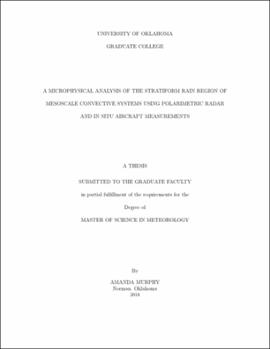| dc.description.abstract | The benefits of using polarimetric weather radar data to infer microphysical properties of and processes within observed precipitation is becoming more widely recognized. The quasi-vertical profile (QVP) technique has emerged as one way to examine vertical profiles of precipitation, but is not ideal for investigations of finescale polarimetric signatures. In this study, a new radar data processing technique, the column-vertical profile (CVP) technique, is introduced as an alternative way to process and present operational polarimetric radar data in a time-height format. Using CVP data, polarimetric ice microphysical retrieval algorithms are used in conjunction with aircraft in situ microphysical data to gain a deeper understanding of the ice microphysical structure of MCSs, and determine the usefulness and effectiveness of such new ice microphysical retrieval algorithms and the CVP technique. In situ aircraft microphysical data from two flights in both the MC3E and PECAN campaigns were analyzed as the UND Citation and P-3 aircraft flew within the stratiform rain region of four total MCSs. Vertical profiles of polarimetric variables were created following the aircraft using the CVP technique, and compared to analogous profiles made with GridRad radar data. CVP profiles were quite similar to those made with GridRad data, except for the enhanced vertical resolution of CVPs, confirming the effectiveness of the CVP technique in resolving vertical profiles of radar data along the flight track.
Novel ice microphysical algorithms were applied to these CVPs to get retrievals of $D_m$, $N_t$, and IWC. Extracting polarimetric radar data from the CVP along the flight track, point-by-point comparisons of in situ aircraft and radar retrieved ice microphysical data were made, and the effectiveness of the retrievals was examined in regions of low $Z_{DR}$, low $K_{DP}$, large CVP distance from the radar, and small distance above the melting layer. It was found that small distance above the ML was the best predictor of poor quality retrievals, with a distance of $\leq 1$ km above the ML related to worse estimates of all 3 variables.
Additionally, these retrievals were performed on QVPs of archetypal MCSs from both midlatitude and tropical environments. In midlatitude MCSs, an increase of $D_m$ and decrease of $N_t$ with depth, with a nearly constant IWC, suggest aggregation through the depth of the cloud. In tropical MCSs, nearly constant $D_m$ paired with increasing $N_t$ and IWC with depth suggest nucleation of new hydrometeors with much weaker aggregation. | en_US |
